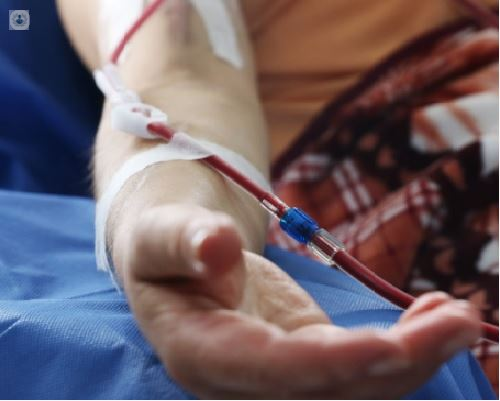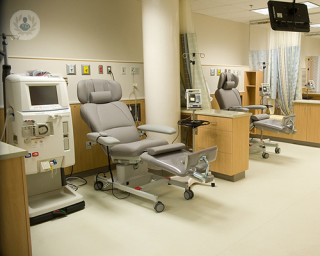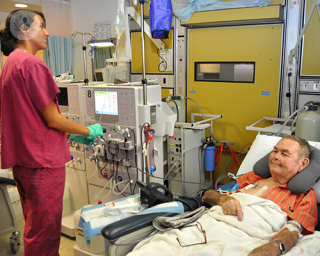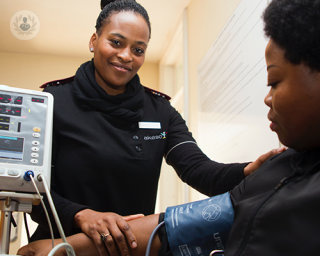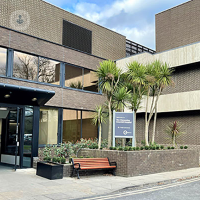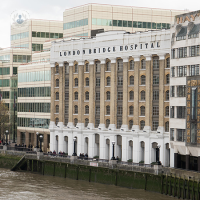Dialysis
Dr Andrew Palmer - Nephrology
Created on: 02-08-2013
Updated on: 10-11-2023
Edited by: Sophie Kennedy
What is dialysis?
Dialysis is a treatment that extracts toxins and excess water from the blood. It acts as a substitute for the kidneys in patients whose own kidneys are not working.
The main function of the kidneys is to remove toxins and liquid from the blood, as the accumulation of waste products in the blood is dangerous. During dialysis, the machine helps the kidneys perform their function. Hence, during the process:
- excess salt, water and waste products are removed so that they do not accumulate in the body
- adequate levels of minerals and vitamins are maintained in the body
Dialysis also helps to control blood pressure and helps in the production of red blood cells.
There are two types of dialysis: haemodialysis and peritoneal dialysis.
Haemodialysis
This is the typical dialysis treatment, characterised by use of an artificial membrane. The blood is cleansed by an artificial kidney, which removes excess water, residues and toxins, then returns the blood to the body. Each session lasts around four hours.
Peritoneal dialysis
Peritoneal dialysis is characterised by use of a natural membrane (the patient’s peritoneum). It consists in removing waste and excess liquid through a tube (catheter) towards a specific part of the abdomen. After a while, the liquid containing the filtered-out waste products is directed outside of the abdomen and discarded. We can distinguish between continuous ambulatory peritoneal dialysis (between 30 and 40 meticulous sessions, four times a day) and automated peritoneal dialysis (performed at night while the patient is asleep).
Why is it done?
Dialysis is performed in patients with renal insufficiency, which is the final phase of chronic kidney disease. This occurs when the kidneys are no longer capable of performing their excretory function and are functioning at between 10 and 15 per cent of their normal levels. The therapy is considered a stop-gap measure until a kidney transplant can be performed; sometimes, it is the only supportive therapy available in cases where transplant is not a viable option.
Some kidney diseases that may require dialysis are: uraemic encephalopathy, pericarditis, acidosis and hyperkalaemia.
What does it involve?
Both types of dialysis have the same goal: to substitute some of the kidney’s functions. Hence, the goal is to eliminate waste products and excess liquid, and equilibrate the amount of electrolytes and other substances.
During dialysis, a semipermeable membrane separates the blood from the dialysis liquid. The membrane only allows certain substances, e.g. waste products, water, electrolytes, to pass from the blood to the dialysis liquid via a process called diffusion.
In dialysis, it is the dialysis liquid which makes it possible to eliminate waste products from the blood. In addition, it contains substances to help correct the misbalances caused by renal insufficiency.
How to prepare for dialysis
Preparation depends on which dialysis method is selected by the nephrologist. Depending on the choice, you may or may not be fitted with a catheter through which the dialysis liquid will be introduced.
Furthermore, it is always advisable to:
- pursue a healthy diet, low in potassium and proteins (a kidney diet)
- continue with your prescribed kidney medication
- rest adequately and sleep before and during dialysis
Care following the intervention
After dialysis, it is normal to feel tired, weak and even to tremble; hence it is recommended to rest when you return home. However, you can resume your everyday activities as soon as you feel better. You must also wash with soap and water the area through which dialysis was introduced, and be careful with the scabs that form.
Alternatives to this treatment
The alternative to dialysis is a kidney transplant. One of the requirements of a kidney transplant is that the patient’s kidney is compatible with the donor’s kidney. A kidney transplant operation usually takes approximately three hours to perform.
